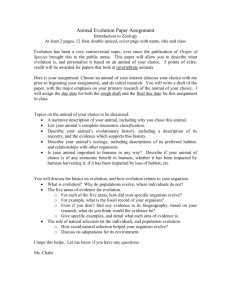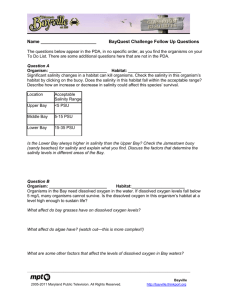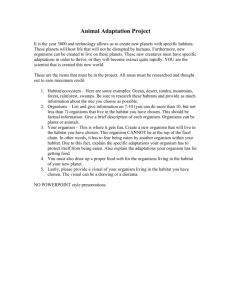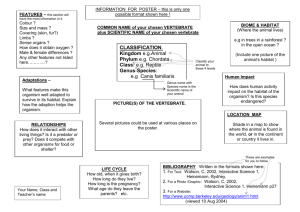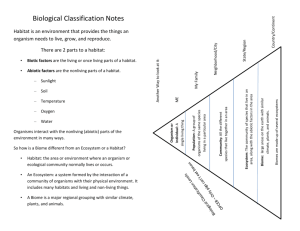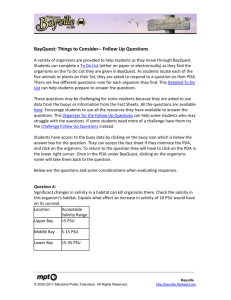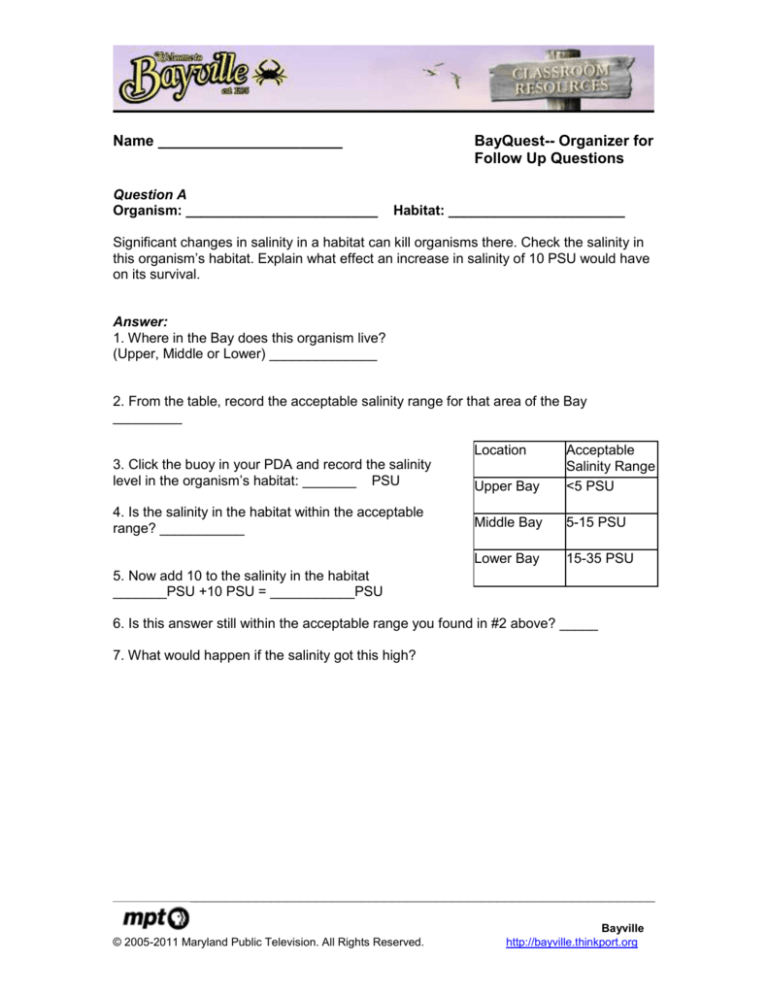
Name ______________________
Question A
Organism: _________________________
BayQuest-- Organizer for
Follow Up Questions
Habitat: _______________________
Significant changes in salinity in a habitat can kill organisms there. Check the salinity in
this organism’s habitat. Explain what effect an increase in salinity of 10 PSU would have
on its survival.
Answer:
1. Where in the Bay does this organism live?
(Upper, Middle or Lower) ______________
2. From the table, record the acceptable salinity range for that area of the Bay
_________
3. Click the buoy in your PDA and record the salinity
level in the organism’s habitat: _______ PSU
Location
Upper Bay
Acceptable
Salinity Range
<5 PSU
4. Is the salinity in the habitat within the acceptable
range? ___________
Middle Bay
5-15 PSU
Lower Bay
15-35 PSU
5. Now add 10 to the salinity in the habitat
_______PSU +10 PSU = ___________PSU
6. Is this answer still within the acceptable range you found in #2 above? _____
7. What would happen if the salinity got this high?
________________________________________________________________________
© 2005-2011 Maryland Public Television. All Rights Reserved.
Bayville
http://bayville.thinkport.org
Name ______________________
BayQuest—p2
Organizer for Questions
Question B
Organism: _________________________ Habitat: _______________________
Organisms in the Bay need dissolved oxygen in the water. If dissolved oxygen levels fall
below 5 mg/L many organisms cannot survive. Is the dissolved oxygen in this organism’s
habitat at a level high enough to sustain life?
Answer:
1. Click the buoy in your PDA and record the dissolved oxygen level in the organism’s
habitat: _______ mg/L
2. Look back at the question. How much oxygen is needed for organisms to live in the
water? ________mg/L
3. Is the level of dissolved oxygen in the habitat high enough to sustain life?
Question C
Organism: _________________________ Habitat: _______________________
The growth of bay grasses and phytoplankton, primary producers in all Bay habitats, is
affected by turbidity. Check the salinity and turbidity levels in this organism’s habitat. Use
the table to determine if the turbidity is in the acceptable range. What are the
consequences if it is not?
Answer:
1. Click the buoy in your PDA.
Record the salinity level in the organism’s habitat
_______________ PSU
Salinity Range Turbidity
Range
<5 PSU
< 17 NTU
5-15 PSU
< 6 NTU
Record the turbidity level in the organism’s habitat
_______________ NTU
15-35 PSU
< 3.5 NTU
2. Look at the table on the right. Find the salinity range your answer from #1 above. It is
________________.
What is the turbidity range that is acceptable for this salinity? __________________
3. Is the turbidity in the acceptable range? _________________
What are the consequences if turbidity is too high?
________________________________________________________________________
© 2005-2011 Maryland Public Television. All Rights Reserved.
Bayville
http://bayville.thinkport.org
Name ______________________
BayQuest—p3
Organizer for Questions
Question D
Organism: _________________________ Habitat: _______________________
What does this organism eat? What organisms eat it? If this organism’s population
suddenly decreased, how would this affect the other organisms in the habitat?
Answer:
1. Click on the organism and read (or listen to) the fact sheet.
2. The organism I found eats __________________________________________
3. The organism I found eaten by ______________________________________
4. If the population of the organism I found decreased what would happen to the
organisms it eats?
5. If the population of the organism I found decreased what would happen to the
organisms that eat it?
Question E
Organism: _________________________ Habitat: _______________________
Invasive species are organisms that are not native to a habitat and spread rapidly
because they have no predators and/or are not susceptible to the diseases that native
species are. Explain how an invasive species of fish might change this organism’s
habitat.
Answer:
1. How might the invasive fish affect the shelter your organism needs?
2. How might the invasive fish change the numbers of predators that your organism has?
3. How might the invasive fish the numbers of prey?
4. Can you think of other affects the invasive fish may have?
________________________________________________________________________
© 2005-2011 Maryland Public Television. All Rights Reserved.
Bayville
http://bayville.thinkport.org
Name ______________________
BayQuest—p4
Organizer for Questions
Final Question:
The PROduction Company would like to know how the health of the Bay affects the
plants and animals that live there.
Answer:
Remember to think about all the factors:
changes in salinity (salt) levels
how turbid (cloudy) the water is
how much dissolved oxygen is in the water
predator/prey relationships
invasive species
What is the story you want to tell? Choose one of the factors and explain how it
affects the plants and animals in the Bay.
________________________________________________________________________
© 2005-2011 Maryland Public Television. All Rights Reserved.
Bayville
http://bayville.thinkport.org



